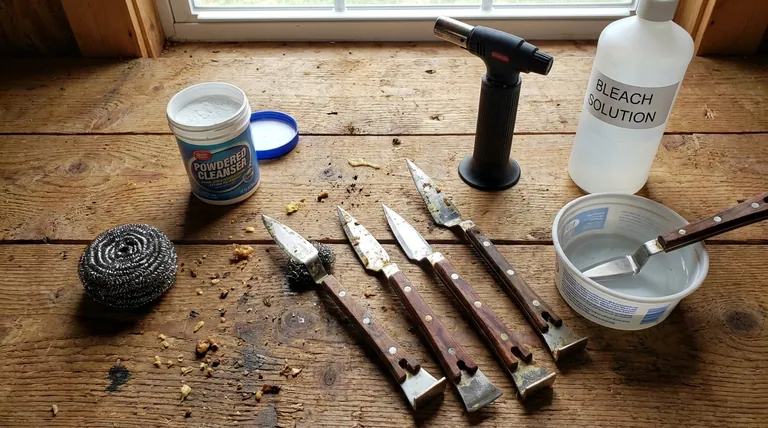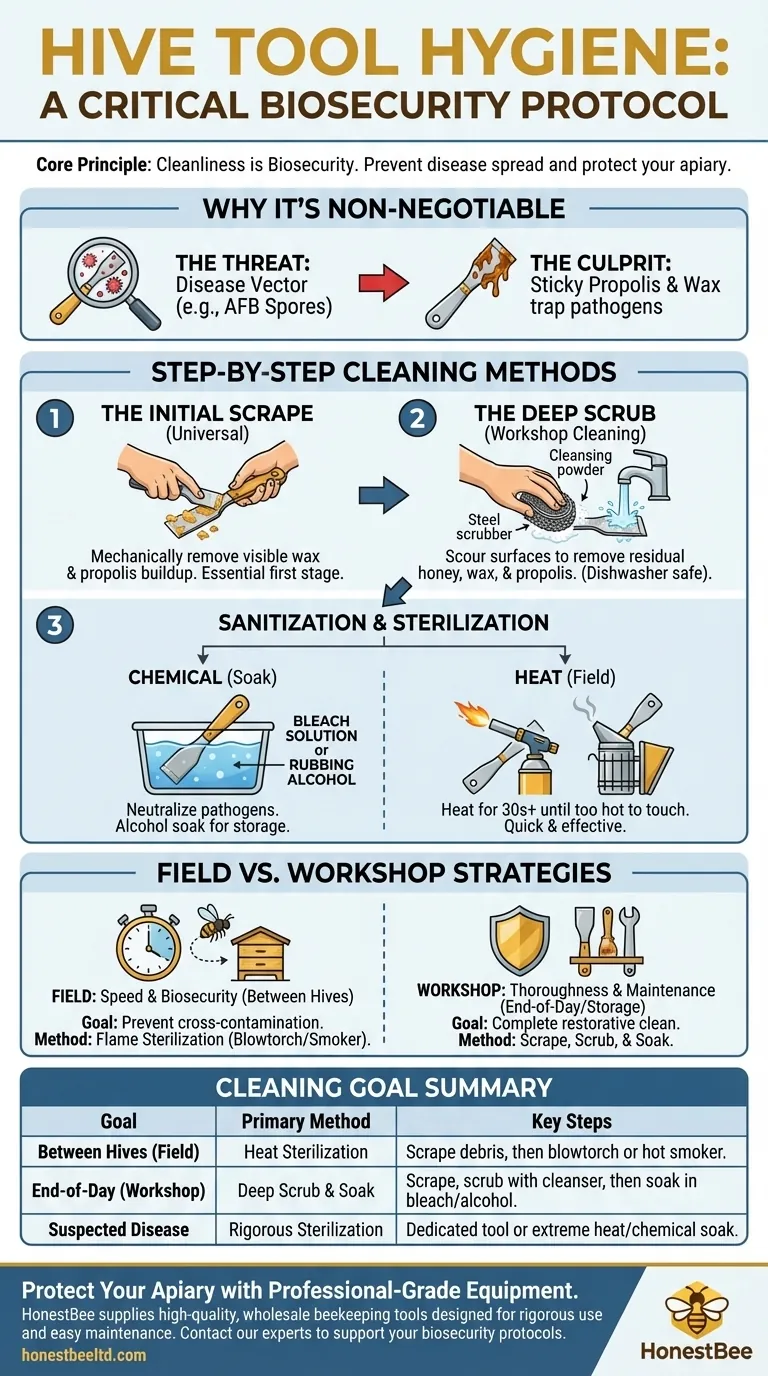To clean a hive tool, you must first scrape off all visible wax and propolis. For a deep clean, scrub the tool with a cleansing powder and a steel scrubber, then sanitize it by soaking it in a bleach solution or rubbing alcohol. For quick sterilization between hives, heating the tool with a blowtorch is a common and effective method.
The core principle of hive tool maintenance is not just about cleanliness, but biosecurity. The method you choose—a quick flame sterilization in the field versus a deep scrub in the workshop—depends entirely on whether your immediate goal is to prevent disease spread or to prepare the tool for long-term storage.

Why Proper Hive Tool Cleaning is Non-Negotiable
A beekeeper's hive tool is a primary vector for transmitting diseases between colonies. Understanding the risks transforms cleaning from a simple chore into a critical biosecurity protocol.
The Threat of Contamination
Sticky substances like propolis and beeswax are excellent at trapping and preserving microscopic pathogens.
Spores from devastating diseases, most notably American Foulbrood (AFB), can easily cling to a dirty tool. Moving from an infected hive to a healthy one with an uncleaned tool can spread the infection and destroy a colony.
The Role of Propolis
Propolis, a resinous mixture collected by bees, is used to seal gaps in the hive. While it has antimicrobial properties within the hive, it is extremely sticky and difficult to remove from tools.
This residue can build up on frame ears and other components, making hive inspections difficult and providing a perfect medium for pathogens to hitch a ride.
Step-by-Step Cleaning Methods
The right cleaning process depends on your situation. A quick sanitization between hives is different from an end-of-season deep clean.
Step 1: The Initial Scrape
This step is universal to all methods. Use the sharp, flat edge of your hive tool (or another scraper) to physically remove as much wax and propolis buildup as possible.
This mechanical removal is the essential first stage, as sterilizing agents cannot effectively penetrate thick layers of debris.
Step 2: The Deep Scrub (Workshop Cleaning)
After the initial scrape, a thorough scrub is needed to remove residual honey, wax, and propolis.
Use hot water, a cleansing powder (like Comet), and a stainless-steel scrubber to scour all surfaces of the tool. For convenience, a hive tool can also be run through a standard dishwasher cycle.
Step 3: Sanitization and Sterilization
This final step neutralizes any remaining pathogens. You have two primary options: chemical sanitization or heat sterilization.
For chemical sanitization, fully immerse the scrubbed tool in a diluted bleach solution or isopropyl (rubbing) alcohol. A soak in alcohol is effective and allows the tool to be stored in the solution until its next use.
For heat sterilization, use a blowtorch to heat the tool's surfaces for at least 30 seconds until it is too hot to touch. Alternatively, you can place the tool directly into the fire pot of a hot, active smoker while pumping the bellows.
Understanding the Trade-offs: Field vs. Workshop
Your cleaning protocol should adapt to your environment and immediate goals. What is practical in the workshop is often not feasible in the apiary.
In the Field: Speed and Biosecurity
When moving between different hives, especially in different apiaries, speed and effectiveness are paramount.
Flame sterilization with a blowtorch or placing the tool in a hot smoker is the gold standard for field use. It is fast, requires no liquids, and effectively kills pathogens on the spot, allowing you to move to the next colony with confidence.
In the Workshop: Thoroughness and Maintenance
At the end of the day or season, the goal is a complete, restorative clean.
This is the time for the full "scrape, scrub, and soak" method. It removes all physical debris, prevents rust, and ensures the tool is perfectly sanitized and ready for storage.
Making the Right Choice for Your Goal
Select your cleaning method based on your specific task to ensure the health and safety of your bees.
- If your primary focus is moving between hives: A quick and thorough flame sterilization is the most efficient way to prevent cross-contamination.
- If your primary focus is end-of-day cleaning for storage: Perform a full scrape and scrub, followed by a soak in rubbing alcohol or a bleach solution to completely sanitize the tool.
- If your primary focus is managing a known or suspected disease: Use a dedicated hive tool for the affected colony, or be exceptionally rigorous with flame sterilization before that tool ever touches another hive.
Proper hive tool hygiene is a simple but powerful practice that directly protects the long-term health of your colonies.
Summary Table:
| Cleaning Goal | Primary Method | Key Steps |
|---|---|---|
| Between Hives (Field) | Heat Sterilization | Scrape debris, then use a blowtorch or hot smoker. |
| End-of-Day (Workshop) | Deep Scrub & Soak | Scrape, scrub with cleanser, then soak in bleach or alcohol. |
| Suspected Disease | Rigorous Sterilization | Use a dedicated tool or extreme heat/chemical soak. |
Protect Your Apiary with Professional-Grade Equipment
Proper hive tool hygiene is fundamental to biosecurity, and using durable, easy-to-clean tools is the first step. HONESTBEE supplies commercial apiaries and beekeeping equipment distributors with high-quality, wholesale beekeeping supplies designed for rigorous use and easy maintenance.
Ensure your operation has the reliable equipment it needs to maintain colony health. Contact our wholesale experts today to discuss your supply needs and how our products support your biosecurity protocols.
Visual Guide

Related Products
- HONESTBEE Premium Italian Style Hive Tool with Hardwood Handle
- HONESTBEE Advanced Ergonomic Stainless Steel Hive Tool for Beekeeping
- HONESTBEE Professional Long Handled Hive Tool with Precision Cutting Blade
- Professional Dual-End Stainless Steel Hive Tool for Beekeeping
- HONESTBEE 15-in-1 Beekeeper Multi-Tool with Hammer and Pliers for Beekeeping
People Also Ask
- How should beekeepers handle bees when using a hive tool? Master Calm, Deliberate Techniques
- What is required for regular inspections in both Flow Hives and Langstroth hives? Essential Beekeeping Tasks Explained
- Is it advisable to manage a large number of hives alone? The Risks of Solo Beekeeping at Scale
- What are some common uses of a hive tool? Essential Multi-Purpose Tool for Every Beekeeper
- What are the basic tools for beekeeping? Essential Starter Kit for Safe & Successful Hive Management



















